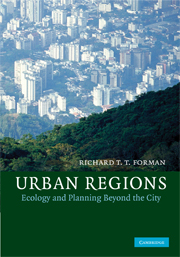Book contents
- Frontmatter
- Contents
- Foreword
- Foreword
- Preface
- Acknowledgments
- 1 Regions and land mosaics
- 2 Planning land
- 3 Economic dimensions and socio-cultural patterns
- 4 Natural systems and greenspaces
- 5 Thirty-eight urban regions
- 6 Nature, food, and water
- 7 Built systems, built areas, and whole regions
- 8 Urbanization models and the regions
- 9 Basic principles for molding land mosaics
- 10 The Barcelona Region's land mosaic
- 11 Gathering the pieces
- 12 Big pictures
- Appendices
- References
- Index
- Plate section
8 - Urbanization models and the regions
Published online by Cambridge University Press: 04 August 2010
- Frontmatter
- Contents
- Foreword
- Foreword
- Preface
- Acknowledgments
- 1 Regions and land mosaics
- 2 Planning land
- 3 Economic dimensions and socio-cultural patterns
- 4 Natural systems and greenspaces
- 5 Thirty-eight urban regions
- 6 Nature, food, and water
- 7 Built systems, built areas, and whole regions
- 8 Urbanization models and the regions
- 9 Basic principles for molding land mosaics
- 10 The Barcelona Region's land mosaic
- 11 Gathering the pieces
- 12 Big pictures
- Appendices
- References
- Index
- Plate section
Summary
Suppose you placed a small oval rug-sized aerial photo of your favorite city in the center of a huge room, and invited a group of children to paint a “mural” on the floor. Lots of trees and buildings and roads and playgrounds and people and farmland and water might appear. Some children may work together to portray a neighborhood, while others play follow-the-leader and create repeated patterns. Most would probably paint their own idiosyncratic visions. The resulting mural could be artistically delightful. But would it be a promising model for your city, as it spreads outward progressively meshing with surrounding land?
The preceding three chapters have highlighted existing patterns of urban regions worldwide. A rich array of sites and resources appears in the wide ring of land surrounding our metropolitan areas. In this chapter on urbanization we turn to change, especially changing spatial patterns and their consequences, as metropolitan areas spread outward (Godron and Forman 1983, Forman and Godron 1986, Forman 1995, Lindenmayer and Fischer 2006). This dynamic view of an urban region is central to ecological understanding and to wise planning. A static or constant world is impossible. Maintaining valuable human and natural resources over time requires flexibility, even adaptability, to get through gradually changing conditions. Gradual urbanization is one of the most conspicuous changes around cities (Turner et al. 1990, Meyer and Turner 1994, Germaine et al. 1998, Schneider et al. 2003).
In essence, urbanization refers to densification and outward spread of the built environment.
- Type
- Chapter
- Information
- Urban RegionsEcology and Planning Beyond the City, pp. 198 - 222Publisher: Cambridge University PressPrint publication year: 2008



